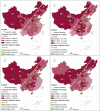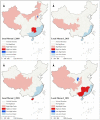Spatial and temporal analysis of China's healthcare resource allocation measurements based on provincial data: 2010-2021
- PMID: 38074731
- PMCID: PMC10699437
- DOI: 10.3389/fpubh.2023.1269886
Spatial and temporal analysis of China's healthcare resource allocation measurements based on provincial data: 2010-2021
Abstract
Background: With the development of society, industrialization, urbanization, aging, lifestyle and social transformation, environmental degradation, global warming and other factors have had a great impact on the health of the population, and there is an urgent need to take a series of practical actions to promote the improvement of national health. Among them, healthcare resource allocation plays a key role in advancing the level of national health, treatment of chronic diseases, and leisure and healthcare.
Methods: This article collected panel data on healthcare resource allocation in all provinces of China from 2010 to 2021, and comprehensively applied Analytic Hierarchy Process, comprehensive scoring method, regional difference analysis and spatial autocorrelation analysis to reveal regional differences, spatial-temporal patterns and development characteristics of healthcare resource allocation in China.
Results: In terms of regional differences, intra-regional differences in healthcare resource allocation tend to narrow and inter-regional differences tend to widen. In terms of spatial pattern, the western provinces on the left side of the Hu Huanyong line generally have higher scores, while the central and eastern provinces on the right side of the Hu Huanyong line have lower scores, and healthcare resource allocation in the provinces on the left side of the Hu Huanyong line, such as Tibet, Xinjiang, Qinghai, Ningxia, Gansu, Inner Mongolia, Sichuan, have the spatial characteristics of HH clusters in terms of geographic location, while the southeast coastal provinces, such as Zhejiang, Fujian, Guangdong, Hainan, have the spatial characteristics of LL clusters in terms of geographic location. From the quadrant analysis, the 2010-2021 healthcare resource allocation in the first quadrant concentrates most of the provinces in the western and northeastern regions, while the third quadrant concentrates most of the provinces in the eastern region.
Conclusion: The allocation of healthcare resources in China's four major zones has undergone a process of change from "unbalanced quantity to relatively balanced quantity," but high-quality healthcare resources are highly concentrated in the eastern part of the country, and the problem of contradiction between people and doctors is prominent. It is recommended that Internet plus healthcare technology be used to reshape the regional allocation of high-quality healthcare resources.
Keywords: China provinces; healthcare resource allocation; regional differences; spatial autocorrelation; spatial–temporal pattern.
Copyright © 2023 Ren, Li and Huang.
Conflict of interest statement
The authors declare that the research was conducted in the absence of any commercial or financial relationships that could be construed as a potential conflict of interest.
Figures





References
-
- Hu ML, Chen SH. Measurement of healthcare resource allocation efficiency and spatial-temporal evolution analysis. Stat Decis. (2023) 2023:17.
-
- Gao JC, Liu Y. Did fiscal expenditure really improve the efficiency of medical resource allocation? China Soft Sci. (2022) S1:241–51.
-
- Li J, Yang F, Mao ZF. Analysis of equity and efficiency in healthcare resource allocation at county level in Hubei Province. Statist Decis. (2017) 13:114–7. doi: 10.13546/j.cnki.tjyjc.2017.13.028 - DOI
-
- Tian LL, Zhang J, Wang FH. Rural public medical resources allocation spatial optimization towards equity and efficiency access: a case study on Xiantao City. Hubei Prov Sci Geogr Sin. (2019) 39:1455–63. doi: 10.13249/j.cnki.sgs.2019.09.01 - DOI
-
- Tao ZL, Dai TQ, Song CQ. Improving spatial equity-oriented location-allocation models of urban medical facilities. Acta Geograph Sin. (2023) 78:474–89.
Publication types
MeSH terms
LinkOut - more resources
Full Text Sources

